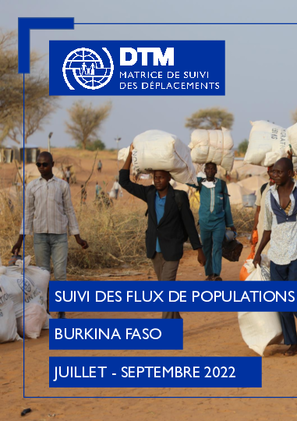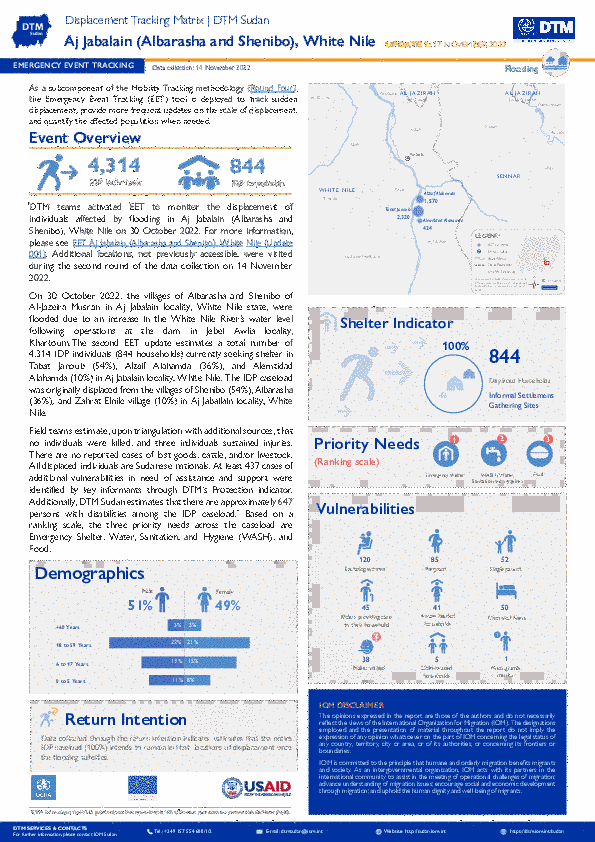-
Countries
-
Data and Analysis
-
Special Focus
-
Crisis Responses
Contact
DTM Niger, NigerDataResearch@iom.int
Location
Niger
Activity
- Mobility Tracking
- Village Assessment
Period Covered
Jul 14 2022 -Aug 30 2022
A village assessment survey (VAS) is a sub-component of mobility tracking. It collects data on returning IDPs, IDPs, returned migrants and host community members. VAS evaluates the absorption capacity of villages to receive returning IDPs with a focus on accessibility of services, livelihoods and reintegration.
Population Groups
Survey Methodology
Unit of Analysis Or Observation
Type of Survey or Assessment
Keywords
Geographical Scope
Administrative boundaries with available data
The current dataset covers the following administrative boundaries

Contact
DTM Burkina Faso, BFInformationUnit@iom.int
Language
French
Location
Burkina Faso
Period Covered
Jul 01 2022
Sep 30 2022
Activity
- Survey
- Flow Monitoring Survey
- Flow Monitoring
Le suivi des flux de populations récolte des données sur les flux et tendances migratoires, les profils des voyageurs et les parcours et intentions des migrants, afin de fournir une meilleure compréhension des mobilités en Afrique de l’Ouest et du Centre.
Au Burkina Faso, la DTM recueille des données au niveau de 4 Points de suivi des flux (Flow Monitoring Points, FMP) que sont Dori/Seytenga, Kantchari, Faramana et Yendéré répartis dans 4 régions afin d’obtenir une meilleure compréhension de l’ampleur, des tendances, des caractéristiques socio-démographiques et des parcours des flux de voyageurs traversant ces différents points.
Ce rapport présente les données recueillies dans le cadre des activités d’enregistrement des flux et d’enquêtes individuelles durant le troisième trimestre de l’année 2022

Contact
DTM Sudan; dtmsudan@iom.int
Language
English
Location
Sudan
Snapshot Date
Nov 14 2022
Activity
- Mobility Tracking
- Event Tracking
The DTM Emergency Event Tracking (EET) is deployed to track sudden displacement and population movements, provide more frequent updates on the scale of displacement, and quantify the affected population when needed. As a subcomponent of the new Mobility Tracking methodology in Sudan (Round Four), and activated on a need basis, EET utilises a broad network of key informants to capture best estimates of the affected population presence per location – a useful tool for humanitarian response planning and design.
Contact
DTMUkraine@iom.int
Location
Ukraine
Activity
- Mobility Tracking
- Baseline Assessment
Period Covered
Oct 31 2022 -Nov 11 2022
A baseline assessment is a sub-component of mobility tracking. It aims to collect data on IDP, migrant or returnee population presence in a defined administrative area of the country.
This is a restricted dataset. To get access, kindly click on the 'Request Access' button.
Population Groups
IDPs
Survey Methodology
Unit of Analysis Or Observation
Admin Area 2
Type of Survey or Assessment
Key Informant
Keywords
Geographical Scope Partial Coverage
Administrative boundaries with available data
The current dataset covers the following administrative boundaries
Contact
DTMUkraine@iom.int
Location
Ukraine
Activity
- Mobility Tracking
- Baseline Assessment
Period Covered
Oct 31 2022 -Nov 11 2022
A baseline assessment is a sub-component of mobility tracking. It aims to collect data on IDP, migrant or returnee population presence in a defined administrative area of the country.
Population Groups
Survey Methodology
Unit of Analysis Or Observation
Type of Survey or Assessment
Keywords
Geographical Scope
Administrative boundaries with available data
The current dataset covers the following administrative boundaries

Contact
DTM Djibouti, DTMDjibouti@iom.int
Language
English
Location
Djibouti
Period Covered
Oct 01 2022
Oct 31 2022
Activity
- Flow Monitoring
In October 2022, 22,083 movements were observed at the Flow Monitoring Points (FMPs) in Djibouti, representing a daily
average of 712 movements. Migration flows increased by 18 per cent compared to September, during which 18,773 movements
had been registered. It is worth highlighting that in October migration flows were above pre-COVID19 levels (between March 2019 and March 2020, the daily average was 654). Of these 22,083 movements, 3,453 (16%) were observed in Obock. This coastal region of Djibouti is the main gateway for migrants going to and returning from the Arabian Peninsula. Migrants regroup at gathering points in the Obock region where they then cross the Gulf of Aden on boats along the so-called Eastern route.
Compared to the period between January and October 2021, movements from Ethiopia have increased sharply by 82 per cent
with 123,058 entries between January and October 2022. However, compared to September 2022, these movements increased
by 18 per cent in October 2022. Furthermore, the number of Ethiopians who have returned from Yemen has more than tripled
from September to October 2022 (from 187 to 648).

Contact
DTM Djibouti, DTMDjibouti@iom.int
Language
French
Location
Djibouti
Period Covered
Oct 01 2022
Oct 31 2022
Activity
- Flow Monitoring
En octobre 2022, 22 083 mouvements ont été observés aux points de suivi des flux (FMP) à Djibouti, ce qui représente une
moyenne quotidienne de 712 mouvements. Les flux migratoires ont augmenté de 18% par rapport au mois de septembre 2022, au cours duquel 18 773 mouvements avaient été enregistrés. Il est intéressant de souligner qu'en octobre, les flux migratoires ont dépassé les niveaux observés pendant la période antérieure à la pandémie de COVID-19 (entre mars 2019 et mars 2020, la moyenne quotidienne était de 654).
Sur ces 22 083 mouvements, 3 453 (16%) ont été observés dans la région d’Obock. Cette région côtière de Djibouti est la
principale porte d'entrée des migrants à destination et en provenance de la péninsule arabique. Les migrants se regroupent aux points de rassemblement dans la région d'Obock d’où ils traversent ensuite le golfe d'Aden sur des bateaux le long de ce qu'on appelle la route de l'Est.
Par rapport à la période de janvier à octobre 2021, les mouvements depuis l'Éthiopie ont augmenté de 82% avec 123 058
entrées entre janvier et octobre 2022. Par rapport à septembre 2022, ces mouvements ont augmenté de 18% en octobre 2022. Par ailleurs, le nombre d'Éthiopiens revenus du Yémen a plus que triplé de septembre à octobre (de 187 à 648)

Contact
DTM Colombia, DTMColombia@iom.int
Language
Spanish
Location
Colombia
Period Covered
Oct 01 2022
Oct 31 2022
Activity
- Flow Monitoring
El presente reporte DTM incluye información de caracterización por sexo y rango etario de la población refugiada y migrante nacional venezolana presente en los departamentos de Colombia seleccionados para la recolección y su intención de desplazamiento hacia otros países de la región.
This snapshot provides an overview of the impact of drought on human mobility in the region, with a focus on Djibouti, Ethiopia, Kenya and Somalia. As of November 2022, an estimated 1.8 million people were displaced by drought, 5 million were living in drought-affected areas, 260,000 migrants were moving to and from such areas, added to 75,000 pastoralist dropouts.

Contact
DTM Nigeria, AllUsersInDTMNigeria@iom.int
Language
English
Location
Nigeria
Period Covered
Oct 28 2022
Nov 01 2022
Activity
- Other
- Survey
- Event Tracking
The rainy season in Nigeria typically occurs annually with the greatest concentration of precipitation between the months of June and September. Many states in Nigeria have been affected by unprecedented heavy rainfalls and floods have devastated various communities. Infrastructure, crops, and shelters have been damaged which led to decimated livelihoods and the displacement of numerous households. Over the past months, climate variability and the release of excess water from the Lagdo dam in northern Cameroon, have worsened the flood situation and has resulted in a renewed situation of widespread displacement across Nigeria.
Between 28 October and 1 November 2022, DTM, in collaboration with the National Emergency Management Agency (NEMA), the Kogi State Emergency Management Agency (KGSEMA) and the Nigerian Red Cross Society (NCRS) identified 31 locations in Kogi State that were affected by the floods and/or received IDPs that are currently displaced as a result of the floods.
In the eight (9) Local Government Areas (LGAs) of Kogi state that were assessed, DTM identified 472,218 individuals in 74,436 households that were affected by the floods. These individuals included both IDPs that were living in camp-like settings and residents impacted by the floods but remained in their communities.

